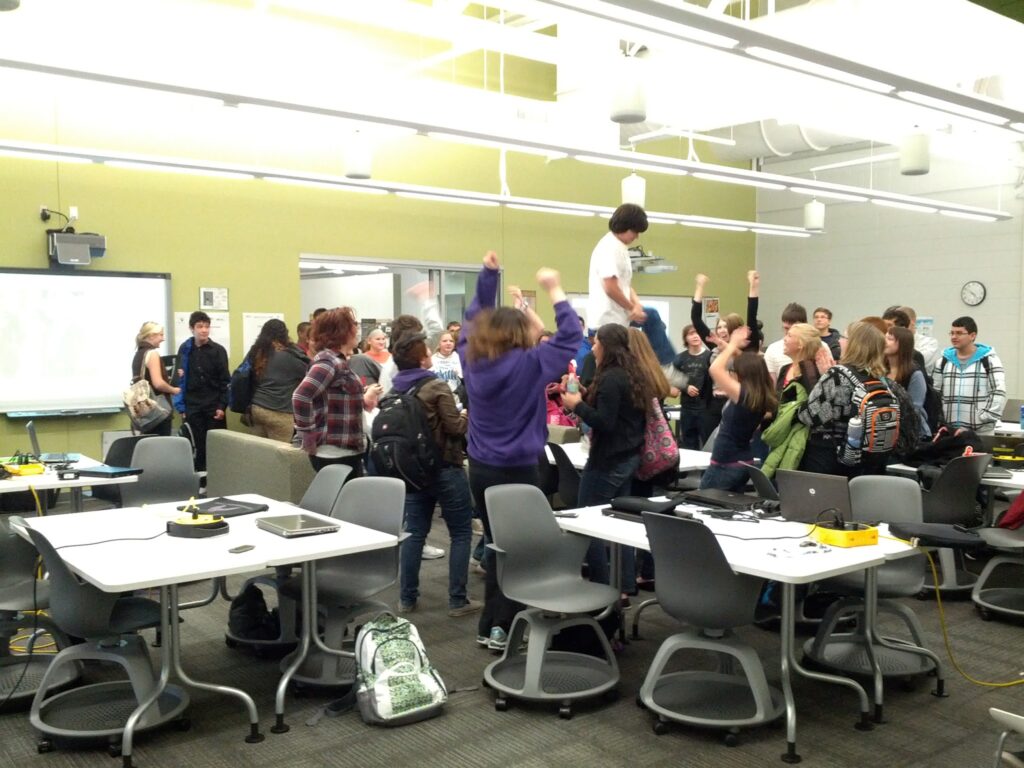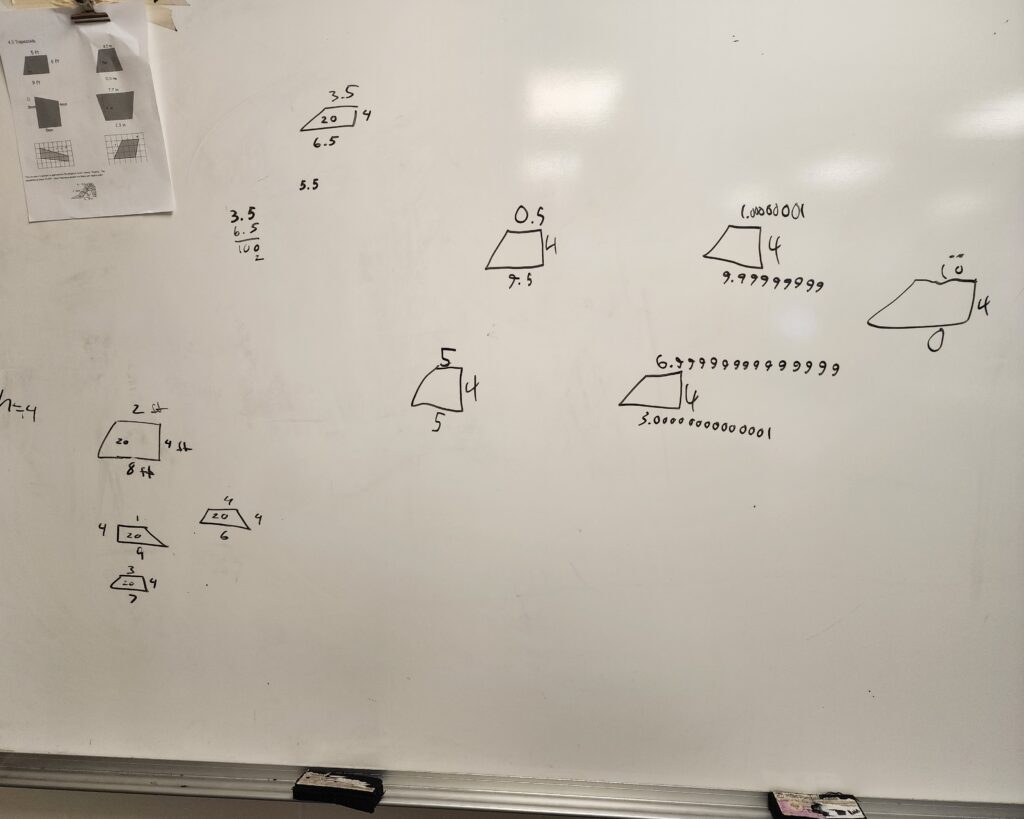As I have written about several times, I am using Vertical Non Permanent Surfaces (VNPS or boards for short) from Peter Liljedahl’s Thinking Classroom, extensively this year. Students love it, and I get excellent, real time feedback on their mathematical thinking. Of course whiteboards can be used for any subject beyond math to get students thinking and talking. But even the best strategies in the classroom are not effective all of the time.
Sometimes students get restless or tired of the same routine. Sometimes the activity that I have planned tanks horribly. Students start to get off task. They may be doodling pictures at the boards, wandering the room and socializing with others, throwing erasers, or just passively sitting instead of collaborating with their teammates. Much of the time my back is to the room as I check in with a particular group. If I let these small behaviors go, things can escalate quickly.
So here are 8 things to try when students start messing around at whiteboards.
Clear Expectations
How one frames the class is critical. Set expectations daily before starting work at the boards. Remind students what they should (working together, sharing the marker, thinking, checking each other’s work, etc.) and should not (sitting, doodling, wandering, erasing other’s work, only watching, etc.) be doing. Stick with firm but fair consequences. It is important to establish a culture that time at the boards is for thinking and working, not socializing.
SEL Lesson
If you notice a trend starting of conduct that is unacceptable than plan a five minute mini-lesson on an SEL competency such as collaboration or perseverance. Target the specific behavior you observe to discuss and focus on improving that day. This might be with a small group or the whole class as needed. Challenge students to work on that skillset for the day and have them reflect at the end of the class on how they did. They could do a quick Turn and Talk with their group or rate themselves on Fist to Five on how they did. If you see groups or individuals still struggling have a private conversation about your observations and challenge them to improve tomorrow. Consistently talking about SEL skills and reflecting on them is a great way to grow them in students.
Remove Individuals
Sometimes one or two students are sabotaging the class with their choices. Avoid “punishing” the whole class in this circumstance. Instead send the individuals back to their seats to work by themselves for the day while the rest of the class continues board work. Prepare a couple of extra copies of the activity and have these students work alone. Remind them that this is only for today and that they can try again to work with a group tomorrow. Most students want to be at the boards with others and this will motivate them to monitor themselves.
Slice Better
It is important to reflect when an activity goes poorly. There is a difference between one or two off-task students seeking attention vs. most of the class not engaging with the content. Oftentimes the fault lies with the teacher. Was the task too easy or too difficult? Easy tasks can lead to boredom, while too challenging ones might cause students to give up easily. Properly thin sliced problems gradually build on students previous knowledge to the new content. Thin slicing is not simple to design, especially when you are new to using boards. I have erred in both directions of too easy and too hard. When this happens, don’t beat yourself up. You are learning this process too. Adjust as necessary to where your students are at and keep trying.
Non-Curricular Problems
Sometimes repeatedly solving thin sliced problems feels just like going through the textbook. Students become bored with the routine. Mix it up by throwing in a day with a non-curricular thinking problem to get students re-energized at the boards. Better yet try an open-ended problem connected to your current content standards. Check out Geoff Krall’s curriculum maps or a 3 Act Task for great ideas in math.
Shorten Duration
One thing that I have noticed is that my students can not work all hour at the boards on thin sliced problems. It is too long, and they start to lose interest. I have found that 20-30 minutes is a good maximum for 6th graders. Then I shift to consolidation of their work and check your understanding problems at their individual seats. They can still work with their elbow partner so they are not alone, but the variety in structures helps them focus. Consider the age and maturity of your students and pay attention to how long they stay on task on a normal day and plan your board time accordingly.
Math Lottery
A math lottery is a fun way to encourage focus that a colleague shared with me. Basically you project a number chart and students get to write their initials down for each problem that they get correct. At the end of class do a random drawing to reward a few numbers. Or try the unfair version. Although these seem designed for individual student work, I did mine by groups at boards and rewarded students for collaboration rather than for getting problems correct.
Take a Break
If your students work at boards often (3-5 times a week) they may get tired of the same old, same old. It’s human nature to both thrive in structure while finding it monotonous after awhile. It’s ok to take a break from the boards and try a PBL project or even a traditional lesson once in a while. If you spend a week or so on other things, students will start to ask when they are doing boards again and be excited to get back to it.
Perspective
In summary I think it is important to keep a big picture perspective. All of your students are not 100% on task all of the time no matter what you do in class. They are human, and some days they may be distracted from something outside of your class, tired from lack of sleep or too many extra curricular activities, stressed from a family situation, or just feeling unmotivated and bored that day. All of this is fine and normal.
It is not our job to have 100% student engagement at all times.
That is unrealistic and only leads to feelings of defeat and burnout. Aim to engage most students, most of the time and adjust your plans when you feel a critical mass of students are off task.
Learn with me!
Are you interested in professional development for your school on how to infuse whiteboards? Of course, I highly recommend PBL as the ideal framework to use. I would love to have a conversation on how I can help. I am now scheduling workshops and book studies for this summer. Check out my workshop page or drop me an email at mikejkaechele@gmail.com. I would love to chat and co-plan meaningful PD for the educators at your school.
Pulse of PBL



